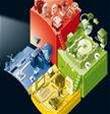
Speaking at Microsoft's Professional Developer Conference (PDC) in Los Angeles, senior vice president for Windows Steven Sinofsky conceded that Vista had not gone as well as the company hoped, and said things would be different with Windows 7.
"The ecosystem wasn't as ready for the launch of Vista as we would have liked. Drivers weren't there, application compatibility wasn't there," he admitted.
Although Microsoft has not yet specified system requirements for Windows 7, Sinofsky said the company was "pleased with performance even on low-end netbooks with an Atom processor and 1GB memory".
But Sinofsky declined to be drawn on a launch date for the software, widely believed to be set for release at the end of 2009. Microsoft has also yet to say when a beta release of the code will be available.
Among the new features showcased at the event was a cleaner user interface designed to let users accomplish tasks faster. There are fewer pop-ups and notifications, and users can also control what appears in their Task Bar and System Tray. A touch-based user interface extends Tablet PC technology to let users control their PC using a fingertip and gestures reminiscent of those supported by Apple's iPhone.
The user interface of Windows 7 will be "quieter" than Vista, with fewer pop-ups and notifications, the company said. Users can also control what appears in their Task Bar and System Tray. Gone is the Windows Sidebar, allowing users to place Gadgets anywhere on the desktop.
Windows 7 PCs will also be able to see each other and access each other's resources on a home network more easily via the new HomeGroup feature, but corporate laptops brought home will not allow this, so as to protect sensitive data, Microsoft said.
On the multimedia side, Windows 7 will support streaming to network-enabled media players, and many more media formats are supported, such as the Advanced Audio Coding (AAC) used by iTunes, Divx and new HD camcorder formats.
Connecting to Wi-Fi networks is also made easier, according to Dennis Flanagan, group program manager for Windows experiences.
"In the system tray, Windows shows the wireless LANs available and you can just pick one, supplying credentials when needed," he said.
Microsoft has also overhauled the way devices work with Windows 7 PCs. Device Stage provides an all-in-one view of a device and what it can do. With a multi-function printer, users will be able to scan, print, fax, and even access any built-in storage from Device Stage, for example.
For corporate users, BitLocker now encrypts USB Flash drives, and administrators can configure a policy so the user must encrypt one before data can be copied to one from a company PC. AppLocker enables administrators to apply a whitelist of applications users are allowed to run, while Windows 7 will also enable an image to be applied to a system without losing user files and data, Microsoft said.

_(20).jpg&h=140&w=231&c=1&s=0)
_(22).jpg&h=140&w=231&c=1&s=0)
.png&h=140&w=231&c=1&s=0)




_(26).jpg&w=100&c=1&s=0)

 iTnews Executive Retreat - Security Leaders Edition
iTnews Executive Retreat - Security Leaders Edition












_(1).jpg&h=140&w=231&c=1&s=0)



